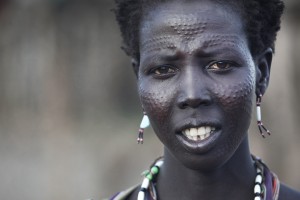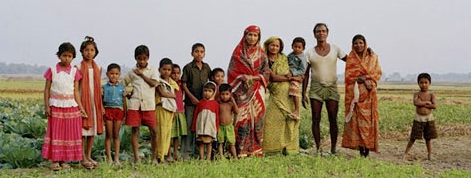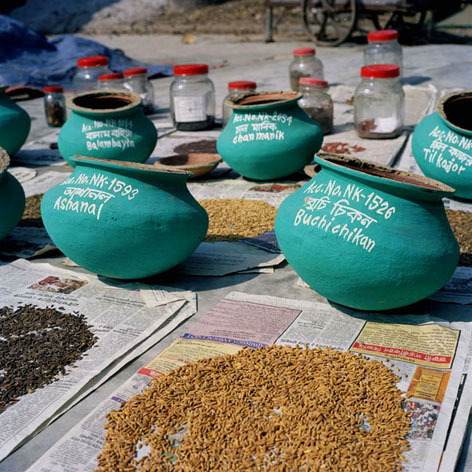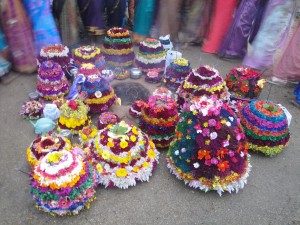Women as Guarantors of Food Security
Women and Biodiversity
Women, peasant and indigenous communities take an active role in the production of food, where seeds form the fundament of agriculture. Women are involved in the cultivation of crops, experimentation and protection. Their food cultures and the various festivals they celebrate are based on biological diversity.
During the famine of 1984 in South Sudan it was learnt through a relief survey of the agropastoral Toposa-people that all the granaries were empty. The women claimed that all the food stocks were consumed. The following year, however, Sorghum fields appeared. When asked, the women replied “We did not dare to tell you that we had hidden our traditional seed varieties. If our husbands had known that we had a stock of seeds they would have forced us to cook them.”
This characterizes the long term strategies of women in ensuring the future of food security, and this can be decisive in the protection and the management of biodiversity. One of the biggest threats to biodiversity is exactly the short term visions, whether it is bound in pure consumerism or wish for quick profits. This essay will explore ways in which women ensure food security for their families and communities through examples taken from biodiversity and traditional knowledge, and a discussion of an ecofeminist/subsistence perspective.
Background

Photo: Steve Evans 2011
People need food to survive, and they need nutritious food to get energy and maintain good health. Women play a key role in production of food. In Africa, 80% of women are involved in food production, 50-60% in Asia and 30-40% in Latin America. Women, therefore are responsible for food and nutritional security of their families and themselves. However, local food security is based on both the availability of biodiversity and access to these. Biodiversity provides us with food, medicines and building materials. Biodiversity is the variety of organisms that includes plants, animals, bacteria, virus, their genes and the ecosystems they live in.
It also includes human diversity. Through centuries of cultivation, protection and management of biodiversity many different varieties of crops were discovered by women, farmers and indigenous peoples. This type of production involves a keen sense of observation, the understanding of ecosystems such as weather patterns, soil types and pollinators. Traditional knowledge plays a key role in further development of diversity.
Cultural and spiritual values are intertwined with biodiversity and traditional knowledge. Traditionally agricultural varieties and knowledge were shared among women, farmers and indigenous peoples for generations through village fairs, harvest festivals, and religious ceremonies that gave them the opportunity for enhancing varieties. However, modernization and commercialization of agriculture adopted a top-down approach where farmers were told what species were good for cultivation. Traditional agriculture was disregarded. The holistic (socio-cultural) aspects that go in enhancing diversity were ignored.
Furthermore, farmers were considered ignorant and their knowledge unscientific. They were told by modern agriculturalists that their ways of cultivation based on mixed farming was unproductive in terms of quantity of grain produced, and that they had to cultivate more to feed the Nation and earn export revenue for the country. Cultivation of food based on diversity for themselves, their families or their communities were not given importance.
Industrial Agriculture
Modern agriculture became increasingly more specialized and industrialized. In this respect the Green Revolution, which started in Asian countries such as India and China in the 1960s and 1970s constitute an important example. Initially it was led by public sector which later turned into agribusiness. This type of agriculture produced standardized varieties, and was based on the use of synthetic fertilizers and pesticides. Furthermore, it was water and power intensive. This was not ecologically sustainable and it was environmentally unsafe. Now India, is preparing to launch the second Green Revolution. According to one farmer who grows 342 varieties of rice in Orissa, the use of hybrid rice will make him dependent on synthetic chemicals, the market and seed companies. His land will become polluted and affect his sovereignty over what to grow. Therefore growing hybrid rice is not an option for him.
The era of genetic engineering started in the 1990s. This is a multi-billion dollar industry. Seeds and the whole life-system were monopolized. The Life technology was based on creating new varieties by using recombinant DNA technology. This involves taking genes from one organism and inserting it into plants. The plants are altered in ways that is not possible in nature. A well known example is transgenic soya produced by Monsanto. This soya plant is resistant to a pesticide called Roundup, also produced by Monsanto.
Such monocultures enable firms to take monopoly rights in the form of patent rights. They control the sale and distribution of seeds, fertilizers and pesticides that come as a package from the multinational corporations. Ultimately the farmer has to buy seeds and rest of the package that go with it year after year. As a result farmers loose control over food production, their creativity is lost and their knowledge becomes useless. Biodiversity – the myriad of varieties cultivated by farmers to suit their environment is lost forever along with their knowledge. Farmers then become consumers. This type of agriculture has for example had dire consequences for farmers and their families in Andhra Pradesh, India. They were unable to repay loans on seeds, pesticides and synthetic fertilizers, and when their crops did not fair well, they resorted to taking their own lives by consuming the pesticides.
The loss of biodiversity and traditional knowledge is detrimental not only for the women but for food security, nutritional security and also endangers health of peoples. It also destroys families. This ultimately threatens the future of traditional agriculture based on diversity.
In contrast to modern agriculture, a recent report tabled in March 2011 before the UN High Commissioner on Human Rights on “Agro-Ecology and the Right to Food” describes that small scale farmers can double food production in 10 years through adopting ecological farming methods. Studies conducted in 57 developing countries show that there is an increase in yield of 80%. For projects in Africa alone the method of production based on ecological agriculture showed an increase by 116%. In Vietnam, Indonesia and Bangladesh the use of insecticides were drastically (92%) reduced that helped in savings for farmers. Local knowledge of agriculture replaced these agricultural inputs. In short, the United Nations Special Rapporteur on the right to Food, De Schutter, adds that in order to tackle hunger, stop climate change, and to feed nine billion people on this planet, agro-ecological methods is the answer. Small-scale farmers ought to be supported in this initiative
Women and Traditional Knowledge of Agricultural Biodiversity
In the following examples we can gather how women’s knowledge, skills and the management of local agro-biodiversity contribute to food security. The examples will also throw light on the cultural and social significance that emphasizes women’s deep understanding of agriculture based on diversity. Modern commercial agriculture has ignored women and the role they play in achieving food security for their children, the elderly and for themselves. Local species and knowledge have also been neglected.

Photo: Katarina Mouratidi
In a village in the Medak district in Andhra Pradesh, India, the Deccan Development Society work with the poorest of the poor, the Dalit (lower caste) women. These women have transformed barren land to fertile land using local biodiversity and knowledge. The women plant diverse crops, a wide variety of millets and pulses, instead of just one type of crop, so that they are sure that they will have something to eat. For the women it is crucial to follow traditional methods of growing crops and have seeds under their control.This gives the women autonomy over food production as they do not have to resort to being dependent on buying seeds. They also gain status in the community.
Women also manage the community seed bank where one of the women had 82 varieties. Seeds are given at no cost for those who need. The borrower is asked to return double the amount of seeds borrowed in order to replenish the seed bank. For these women seeds are a basis of sustenance.
Traditional millets produce multiple securities such as food, nutritional, fodder, fiber and health. There are varieties that can grow on soils that are poor, arid, saline, acidic or sandy. The stalks of millets are used as fodder for cattle. Nutritionally millets are rich in calcium and iron, proteins, vitamins such as lysine and micronutrient such as beta-carotene.
In a village in Ethiopia women grow up to 10 varieties of Sorghum in just one hectare of land, varieties that give high yield, others have sweet taste and so on. Women ensure the yield of Sorghum through keen selection and planting of mixed varieties of seeds. This method of cultivation also allows for cross pollination and genetic exchange between varieties. Sorghum is also the staple food in many parts of Africa. This forms a wholesome food not only in terms of energy, but also for its nutritional content as mentioned above. It is used to make beer, porridge and ingera (a type of pancake). The dough is allowed to ferment before making pancakes thus increasing its nutritional content.
In the State of Karnataka, India, women are actively engaged in agricultural production- they are in charge of the seeds, its cultivation, experimentation, regeneration and preservation. In areas where finger millet is grown, women plant nine different seeds in pots filled with soil with adequate manure. After a week they are checked. The ones that germinate well and look healthy are selected for planting in the fields. When experimentation is over a thanksgiving celebration to the goddess takes place. Some seeds are offered to the local goddess even before sowing. These are then given to the poor who can cultivate them. After harvest grains are given as a gift to women who helped with the harvest. Through these activities women share the traditional knowledge of plants, crop varieties, seed storage, and in turn build communities. The social rituals are, however, lacking for high yielding varieties as these are taken directly to the field, and after harvest men take it to the market.

Photo: Photo Katharina Mouratidi
In the homegardens of Bangladesh women grow a wide variety of indigenous vegetables. Their families benefit in many ways from the produce. The products enhance nutrition of their families and their culinary traditions are maintained. Their subsistence is ensured. The vegetables are often given as gifts or shared, while creating network among themselves.
Initiatives in encouraging diversity
All around the world a multitude of initiatives are taken in order to protect biodiversity and ensure food and nutritional security. The Mahila Anna Swaraj– Food Sovereignty in Women’s hands, India works to reclaim women’s rights to seed sovereignty. By creating a subsistence base such as creating community seed banks and biodiversity registers to document women’s traditional knowledge of biodiversity.
Another movement, the Nayakrishi Aandolan, in Bangladesh is represented by over 100,000 farmers and supported by UBINIG- Policy, Research for Development Institute. According to them seed is considered as the beginning. Its various aspects such as ecological, economic, social, political and cultural relations are taken into account. Their view of agriculture is holistic. Apart from contributing to food security and sovereignty this mode subsistence leads to Ananda means Joy. Achieving joy is one of the main goals of the struggle. Sisters keep the seeds in your hand,” say the women of the movement.
It is a demand for power – the power to decide what to plant and eat for all in the community and not in the form of property relation. The farmers are committed to not only saving seeds but also preserving all biodiversity by mapping oral traditions.
Even in the West, people are resorting to alternative methods in order to get fresh foods and create communities. After the collapse of the automobile industry in Detroit, many local people have started to grow vegetables and herbs in community gardens. This initiative has given them an opportunity to access fresh produce that is nutritionally rich. In addition it helps form communities. In other western countries too people are involved in establishing such gardens and other sustainable activities to create a better life.
Ecofeminism and subsistence perspective
Most of us live in patriarchal societies. According to von Werlhof (2001) patriarchy still exists despite the progress in human societies, and capitalism is the latest stage of patriarchy. Patriarchal-woman relation is based on oppression and exploitation whether it is free women’s labour or natural resources available as free goods for the development of capital. If we take the relation of human beings to nature it is similar, and if we still go back to the colonial period the relation between metropoles and colonies, we can still see the same development (Mies 1986). For urban development the capitalists need the colonies to get access to raw material and free labor, be it a village, a semi-urban area and its resources. And capital never ceases to grow. We need to see these connections in order to understand patriarchal-capitalistic logic including the market logic of today. We can say that we then lived in colonial times and now live in neo-colonial times. Multinational corporations are one of the neo-colonial actors.
Ecofeminism takes into account how women and nature are treated for the accumulation of capital. For the market biodiversity is a free resource that is available free of cost to the market for earning profits. Similarly traditional knowledge of biodiversity helps the market in creating new varieties and is also available free of cost. This knowledge is devalued and non-scientific. Yet it is free for exploitation by the market.
Local self-sufficiency and ecological stability are two important aspects in tackling climate change and achieving food security. These aspects are inherent in subsistence ways of living. However in patriarchal cultures this way of living is devalued and considered as backward. The subsistence perspective takes into account aspects of ecology, culture and biodiversity. This perspective is based on understanding that earth’s resources are finite and we must use it judiciously. Women who subsist on natural resources have understood this and are struggling to maintain their ecology. Self-reliance means having enough and self determination meaning able to decide what to grow is the key to food security. As Gandhi said “the world has enough for everybody’s needs, but not for everybody’s greed”.

Batukamma festival at Rajalingampet. Photo: Katharina Mouratidi
The struggles described above depict the subsistence perspective, which for me is an extension of ecofeminist thought and action. It is holistic and sees biodiversity, protection of traditional knowledge and the ecology as interconnected elements. Respect for and cooperation with natural elements and processes are the basis. Reciprocity is another feature that also comes from the understanding that humans are part of nature. All these elements are embedded in the subsistence perspective, which will help us to tackle the effects of climate change on agriculture. Women can, indeed, lead the way in guaranteeing food security.
/AV Bhanumathi Natarajan
About Bhanumathi Natarajan
Bhanumathi Natarajan has a Master Degree in Botany, and has research experience in ethnobotany from the University of Oslo. She is active in the Non-governmental Organisation; Women`s International League for Peace and Freedom, Bergen, Norway. Bhanumathi Natarajan, Fossaasen 10, 5119 Ulset, Bergen, Norway. Private- + 47 55256680 Mobile- + 47 98616519
Further Resources
Further Resources von Werlhof, C. (2001) Losing Faith in Progress: Capitilistic Patriarchy as an `Alchemical System` in There is an Alternative, Subsistence and Worldwide Resistance to Corporate Globalisation,eds.Benhonnholdt-Thomsen, et. al. Zed Books Ltd., London. Mies, M. (1986) Patriarchy and Accumulation on a World Scale: Women in the International Division of Labour. Zed Books Ltd., London. UBINGIG nettside Organisk jordbruk

